Related Research Articles

Westminster is an area of Central London, England, within the larger City of Westminster, most notable for being the seat of the United Kingdom Parliament and most of the UK Government. It is known for its many visitor attractions and historic landmarks, including the Palace of Westminster, Buckingham Palace, Westminster Abbey, Westminster Cathedral, Trafalgar Square and the West End shopping and entertainment district.
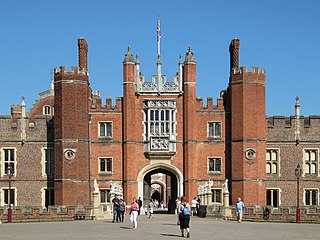
Hampton Court Palace is a Grade I listed royal palace in the London Borough of Richmond upon Thames, 12 miles southwest and upstream of central London on the River Thames. The building of the palace began in 1514 for Cardinal Thomas Wolsey, the chief minister of Henry VIII. In 1529, as Wolsey fell from favour, the cardinal gave the palace to the king to check his disgrace. The palace went on to become one of Henry's most favoured residences; soon after acquiring the property, he arranged for it to be enlarged so that it might more easily accommodate his sizeable retinue of courtiers. The palace is currently in the possession of King Charles III and the Crown.
Pope Severinus was the bishop of Rome elected in October 638. He was caught up in a power struggle with Emperor Heraclius, who pressured him to accept Monothelitism. Severinus refused, which for over eighteen months hindered his efforts to obtain imperial recognition of his election. His pontificate was finally sanctioned on 28 May 640, but he died two months later.

The Chakri dynasty is the current reigning dynasty of the Kingdom of Thailand, the head of the house is the king, who is head of state. The family has ruled Thailand since the founding of the Rattanakosin Era and the city of Bangkok in 1782; following the end of Taksin Thonburi's reign, when the capital of Siam shifted to Bangkok. The royal house was founded by Rama I, an Ayutthaya military leader of Sino-Mon descent.

The Palace of Whitehall at Westminster was the main residence of the English monarchs from 1530 until 1698, when most of its structures, except notably Inigo Jones's Banqueting House of 1622, were destroyed by fire. Henry VIII moved the royal residence to White Hall after the old royal apartments at the nearby Palace of Westminster were themselves destroyed by fire. Although the Whitehall palace has not survived, the area where it was located is still called Whitehall and has remained a centre of government.

The Palace of the Parliament, also known as the Republic's House or People's House/People's Palace, is the seat of the Parliament of Romania, located atop Dealul Spirii in Bucharest, the national capital. The Palace reaches a height of 84 m (276 ft), has a floor area of 365,000 m2 (3,930,000 sq ft) and a volume of 2,550,000 m3 (90,000,000 cu ft). The Palace of the Parliament is the heaviest building in the world, weighing about 4,098,500,000 kilograms, also being the second largest administrative building in the world.
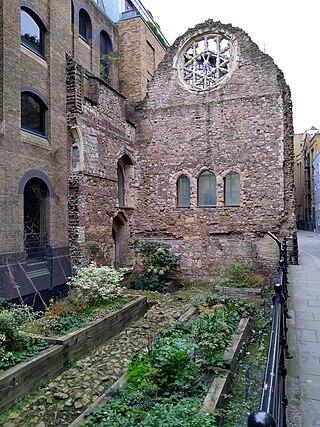
Winchester Palace was a 12th-century palace which served as the London townhouse of the Bishops of Winchester. It was located in the parish of Southwark in Surrey, on the south bank of the River Thames on what is now Clink Street in the London Borough of Southwark, near St Saviour's Church which later became Southwark Cathedral. Grade II listed remains of the demolished palace survive on the site today, designated a Scheduled Ancient Monument, under the care of English Heritage.

Crystal Palace Football Club is a professional football club based in Selhurst in the Borough of Croydon, South London, England, who compete in the Premier League, the highest level of English football. Although formally created as a professional outfit in 1905, the club's origins can be traced as far back as 1861, when an amateur Crystal Palace football team was established at the Crystal Palace Exhibition building. This has led to claims by the club that Crystal Palace should be recognised as the oldest professional football club in the world, after historians discovered a lineage through the Crystal Palace Company. Both the amateur and professional clubs played inside the grounds of the Palace, with the professional club using the FA Cup Final stadium for its home games until 1915, when they were forced to leave due to the outbreak of the First World War. In 1924, they moved to their current home at Selhurst Park.

The Potala Palace is a dzong fortress in Lhasa, Tibet. It was the winter palace of the Dalai Lamas from 1649 to 1959, has been a museum since then, and a World Heritage Site since 1994.

The Royal Palace of Caserta is a former royal residence in Caserta, southern Italy, constructed by the House of Bourbon-Two Sicilies as their main residence as kings of Naples. It is the largest palace erected in Europe during the 18th century. In 1997, the palace was designated a UNESCO World Heritage Site; its nomination described it as "the swan song of the spectacular art of the Baroque, from which it adopted all the features needed to create the illusions of multidirectional space". The Royal Palace of Caserta is the largest former royal residence in the world, over 2 million m3 in volume and covering an area of 47,000 m2.

The Palace of Nations is the home of the United Nations Office at Geneva, located in Geneva, Switzerland. It was built between 1929 and 1938 to serve as the headquarters of the League of Nations. It has served as the home of the United Nations Office at Geneva since 1946 when the Secretary-General of the United Nations signed a Headquarters Agreement with the Swiss authorities, although Switzerland did not become a member of the United Nations until 2002.

Nahar Singh Mahal is located at Ballabhgarh in Faridabad district of Haryana. This fort was built by the forefathers of Raja Nahar Singh around 1739 AD, and after whom Ballabgarh was named, the construction however continued in parts till about 1850. The fort is also known as Raja Nahar Singh Palace.

Palazzo Pamphilj, also spelled Palazzo Pamphili, is a palace facing onto the Piazza Navona in Rome, Italy. It was built between 1644 and 1650.
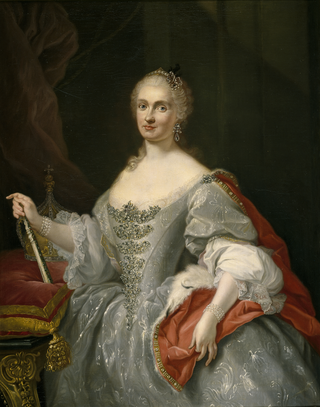
Maria Amalia Christina Franziska Xaveria Flora Walburga of Saxony was Queen of Spain from 10 August 1759 until her death in 1760 as the wife of King Charles III. Previously, she had been Queen of Naples and Sicily since marrying Charles on 19 June 1738. She was born a princess of Poland and Saxony, daughter of King Augustus III of Poland and Princess Maria Josepha of Austria. Maria Amalia and Charles had thirteen children, of whom seven survived into adulthood. A popular consort, Maria Amalia oversaw the construction of the Caserta Palace outside Naples as well as various other projects, and she is known for her influence upon the affairs of state.
The Hekhalot literature from the Hebrew word for "Palaces", relating to visions of ascents into heavenly palaces. The genre overlaps with Merkabah or "Chariot" literature, concerning Ezekiel's chariot, so the two are sometimes referred to together as "Books of the Palaces and the Chariot". The Hekhalot literature is a genre of Jewish esoteric and revelatory texts produced some time between late antiquity – some believe from Talmudic times or earlier – to the Early Middle Ages.

The National Palace was the official residence of the President of Haiti, located in Port-au-Prince, facing Place L'Ouverture near the Champs de Mars. It was severely damaged during a devastating earthquake in 2010. The ruins of the building were demolished in 2012 under the Martelly administration, and plans to rebuild the palace were announced by then president Jovenel Moïse in 2017.

The Crown Prince of Thailand is a title held by the heir apparent to the Thai throne. First created by King Chulalongkorn in 1886, for his son Prince Maha Vajirunhis, the king's eldest son by a royal wife Queen Savang Vadhana. Prior to this, the Siamese throne did not have a law or formal system regulating the royal succession. In 1688 King Petracha of Ayutthaya created the title of Front Palace, which by the Rattanakosin period had become the main title granted to the heir presumptive to the throne. However few Front Palaces have succeeded to the throne this way, with the exception of King Buddha Loetla Nabhalai in 1809. After the death of Bovorn Wichaichan in 1885, the title of Front Palace was abolished and replaced with the title of Crown Prince, who became heir apparent to the throne.
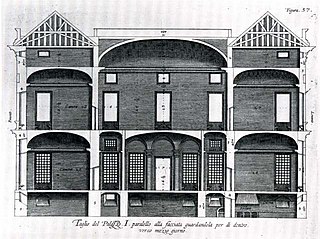
Palazzi di Genova is a 1622 book written and illustrated by Peter Paul Rubens, depicting and describing the palaces of Genoa, Italy in 72 plates. A second volume with 67 further plates was added the same year, and they are usually found together. The illustrations of the second part are usually considered not to be by Rubens though. It is the only book Rubens published himself.
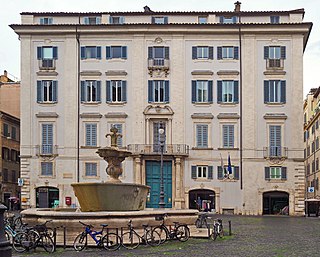
The Palazzo Fusconi-Pighini is a Renaissance-style palace located on Piazza Farnese #44 in the rione Regola of central Rome, Italy.
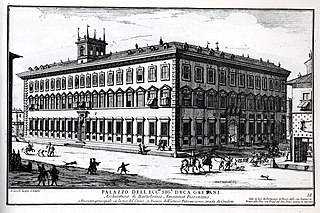
The Palazzo Ruspoli is a Renaissance-style, 16th century aristocratic palace located on Via del Corso 418, where Corso intersects with Largo Carlo Goldoni and the Piazza di San Lorenzo in Lucina, in the Rione IV of Campo Marzio in central Rome, Italy.
References
- ↑ Francke, August Hermann (1992). Antiquities of Indian Tibet. Volume 38; Volume 50 of New imperial series. Asian Educational Services. p. 96. ISBN 81-206-0769-4.